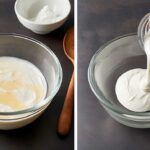About Ice Cream
How to Tell If Your Ice Cream Has Gone Bad

Were you aware that more than 90% of American households regularly enjoy eating ice cream?
But how can we be sure that our beloved frozen treat hasn’t gone bad?
In this article, we will explore the telltale signs that indicate your ice cream may have expired.
From changes in texture to the presence of ice crystals, we’ll arm you with the knowledge you need to enjoy your ice cream with confidence.
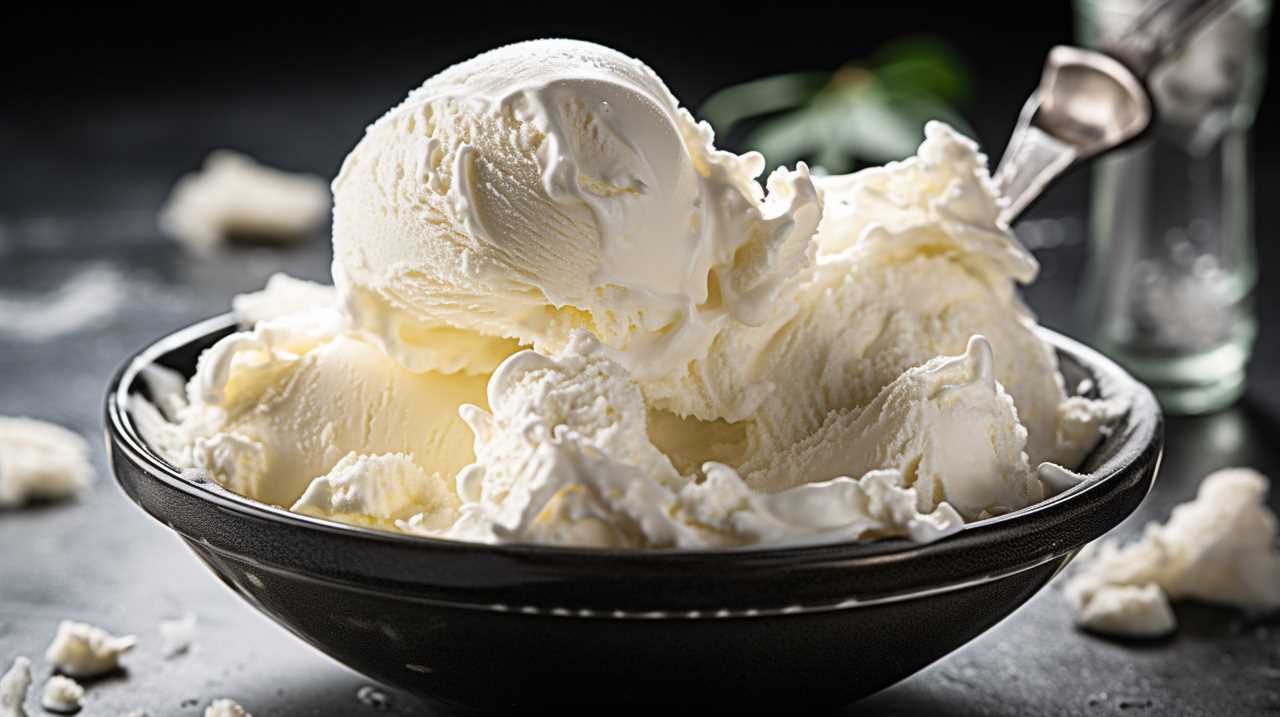
So let’s dive in and learn how to keep our frozen indulgence fresh and delicious!
Key Takeaways
- The expiration date indicates the freshness and safety of ice cream.
- Changes in texture, such as graininess, separation, stickiness, and loss of airiness, can indicate spoilage.
- An off odor, unusual color, or sour taste are clear signs of ice cream spoilage.
- Ice crystals and mold formation are common indicators of ice cream spoilage.
Expiration Date
The expiration date is a crucial indicator of the freshness and safety of our ice cream, ensuring that we, as consumers, can enjoy it at its best quality. It represents the date until which the ice cream is expected to maintain its optimal taste and texture.
Ice cream has a limited shelf life due to its perishable nature, and the expiration date helps us determine when it’s no longer safe to consume. Proper storage methods are essential in maintaining the quality and extending the shelf life of ice cream.
It’s recommended to store ice cream in a freezer set at or below -18 degrees Celsius. Additionally, keeping the ice cream container tightly sealed and away from temperature fluctuations will help preserve its freshness and prevent the growth of harmful bacteria.

Changes in Texture
To determine if ice cream has gone bad, we can observe changes in its texture. The texture of ice cream is an essential aspect of its quality, and any deviations can indicate spoilage or degradation.
Here are five texture-related indicators to look out for:
- Graininess: If the ice cream feels grainy or sandy, it may have undergone temperature fluctuations or improper storage, resulting in the formation of ice crystals.
- Separation: If the ice cream appears watery or has visible liquid separation, it suggests that the emulsifiers and stabilizers have broken down, leading to a loss of smoothness and creaminess.
- Stickiness: A sticky or gummy texture could signify the ice cream has partially melted and refrozen, causing the formation of large ice crystals.
- Loss of airiness: If the ice cream becomes dense and compact, it may have lost air during storage, leading to a less pleasant mouthfeel.
- Alteration of melting point: A significant change in the ice cream’s melting point can indicate spoilage, as it may result from improper freezing or exposure to heat.
Observing these texture changes can help determine if your frozen desserts are still safe to consume.
Off Odor
Next, we’ll explore the second indicator of ice cream spoilage: the presence of off odor. When ice cream has gone bad, it may emit a foul or rancid smell. This off odor is often a result of the growth of bacteria or mold, which can occur when the ice cream isn’t stored properly or when it has exceeded its shelf life.
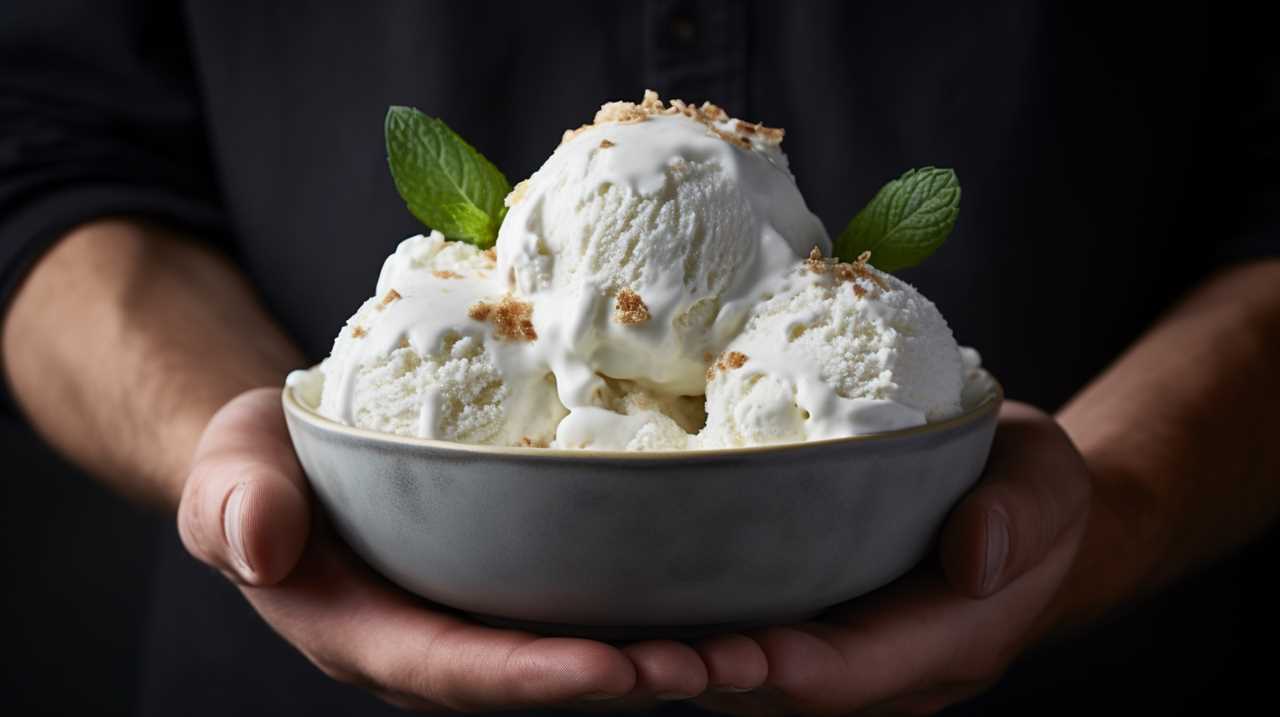
Pay close attention to any unusual or unpleasant odors emanating from the ice cream container. If the ice cream smells sour, putrid, or like spoiled milk, it’s a clear sign that it has gone bad.
Additionally, an off odor may be accompanied by other signs of spoilage, such as an off color or a sour taste. Trust your senses and discard any ice cream that exhibits these indications of spoilage to ensure your safety and enjoyment.
Ice Crystals
One common indicator of ice cream spoilage is the formation of ice crystals within the container. When ice cream is stored improperly, such as being exposed to temperature fluctuations or being kept in the freezer for an extended period, ice crystals can form. These ice crystals are visible as tiny, gritty particles that give the ice cream a grainy texture.
To help you understand the significance of ice crystals in determining the quality of ice cream, here are five key points to consider:

- Ice crystals indicate that the ice cream has undergone temperature abuse during storage.
- Homemade ice cream is less likely to develop ice crystals due to its lower water content compared to store-bought varieties.
- The presence of large ice crystals suggests that the ice cream has thawed and refrozen multiple times, potentially affecting its texture and flavor.
- Properly storing ice cream at a consistent temperature below 0°F (-18°C) can help prevent the formation of ice crystals.
- Avoid buying ice cream that already has visible ice crystals, as this could be a sign of poor quality or mishandling.
Mold Formation
Mold formation is a common issue that can occur in spoiled ice cream. Mold thrives in warm, moist environments, making ice cream a perfect breeding ground. To prevent mold growth, it’s crucial to store ice cream properly.
First, make sure to keep the ice cream container tightly sealed to prevent any air or moisture from getting in. Store it at a temperature below freezing, ideally at -18°C or lower, to inhibit mold growth. Avoid placing the ice cream container in the door of the freezer, as temperature fluctuations can occur.
Additionally, it’s best to consume the ice cream within a few months of purchase to minimize the risk of mold formation. By following these storage guidelines, you can enjoy your ice cream without worrying about mold contamination.
Frequently Asked Questions
Can Ice Cream Go Bad Before the Expiration Date?
Ice cream can spoil early, even before the expiration date. To prevent this, store it at the proper temperature, avoid thawing and refreezing, and check for signs of texture change or off flavors.

Why Does Ice Cream Sometimes Have a Grainy Texture?
Ice cream can have a grainy texture due to the freezing process. When water in the ice cream forms large ice crystals, it can create a gritty sensation. This happens when the ice cream is not properly churned or stored at too high of a temperature.
Can Ice Cream Still Be Safe to Eat if It Doesn’t Have an off Odor?
Ice cream can still be safe to eat even if it doesn’t have an off odor. However, it’s always best to check the expiration date to ensure freshness and quality.
What Causes Ice Crystals to Form in Ice Cream?
Ice crystals in ice cream form due to temperature fluctuations and the presence of water molecules. To prevent this, manufacturers use stabilizers and emulsifiers. Understanding these causes and prevention methods ensures a smoother, creamier treat.
Is It Safe to Eat Ice Cream if It Has Small Spots of Mold on the Surface?
We need to determine if it is safe to eat ice cream with small spots of mold on the surface. Mold can produce harmful toxins, so it is best to discard any ice cream that shows signs of mold.

Conclusion
In conclusion, identifying the signs of spoiled ice cream is crucial to ensuring food safety. By being observant of the expiration date, changes in texture, off odors, the presence of ice crystals, and mold formation, one can determine if the ice cream is no longer suitable for consumption.
Just like a skilled detective unraveling a mystery, detecting these indicators is like uncovering hidden clues that safeguard our health and enjoyment of this delightful frozen treat.
Beyond the realm of flavor and technique, Adriano recognizes the importance of sustainability and conscious consumption. His writing often explores eco-friendly practices within the ice cream industry, highlighting the use of locally sourced ingredients, reducing waste, and supporting ethical production methods.
About Ice Cream
What Joyful Flavors of Ice Cream Does Joy Ice Cream Offer?
Uncover the unexpected and unique flavors awaiting at Joy Ice Cream – you won't want to miss these tantalizing treats!

As we dip into the world of Joy Ice Cream, we uncover a symphony of flavors waiting to tantalize our taste buds. From the familiar comfort of classic vanilla to the unexpected fusion of exotic fruits, Joy Ice Cream has something for every palate.
But what about those seeking a unique twist or a seasonal surprise? Stay tuned as we uncover the hidden gems that make Joy Ice Cream stand out among the rest.
Key Takeaways
- Classic flavors like vanilla, chocolate, and strawberry delight with rich and creamy textures.
- Exotic combinations such as coconut with almonds and creative pairings cater to adventurous taste buds.
- Seasonal specials like pumpkin spice and cherry blossom showcase Joy Ice Cream's creativity.
- Vegan options using coconut milk offer guilt-free indulgence for lactose intolerant individuals.
Classic Flavors
Classic Ice Cream flavors by Joy Ice Cream are a delightful combination of timeless favorites that never fail to satisfy cravings for something sweet and indulgent.
The vanilla ice cream, a classic favorite, is a versatile choice that complements a wide range of desserts. Made with high-quality ingredients, this vanilla ice cream boasts a rich and creamy texture that melts smoothly on the palate, leaving a satisfying taste of pure indulgence.
On the other hand, the chocolate ice cream stands out for its intense cocoa flavor and velvety consistency, offering a decadent treat for chocolate lovers.
Joy Ice Cream's strawberry ice cream, crafted with real strawberries, delivers a refreshing and fruity burst with every scoop. Each of these traditional flavors is carefully prepared to ensure a premium taste experience that captures the essence of joy in every bite.
Enjoy the convenience of Joy Ice Cream delivery to savor these classic favorites in the comfort of your own home.
Exotic Combinations

Venture into a realm of culinary creativity with Joy Ice Cream's Exotic Combinations, where tropical sweetness meets adventurous flavors in every scoop. The exotic combinations at Joy Ice Cream offer a delightful twist to traditional flavors, satisfying even the most daring taste buds. By combining coconut flavored ice cream with butter-roasted almonds and chocolate chips, customers are treated to a burst of flavors that transport them to a tropical paradise. These bold and delicious options have left many customers satisfied and coming back for more. Joy Ice Cream prides itself on using high-quality ingredients to create these unique flavors, ensuring a premium experience with every bite. The creative pairings of ingredients set Joy Ice Cream apart, making it a go-to destination for those seeking a one-of-a-kind ice cream adventure.
| Flavor Combinations | Description |
|---|---|
| Coconut flavored ice cream with butter-roasted almonds and chocolate chips | A tropical delight with a crunchy twist |
| Unique combinations | Bold and delicious options for the adventurous palate |
| High-quality ingredients | Ensuring a premium and satisfying ice cream experience |
| Creative pairings | Innovative flavors that set Joy Ice Cream apart |
| Satisfied customers | Raving reviews from those who have tried these exotic flavors |
Seasonal Specials
During each season, Joy Ice Cream introduces a lineup of tantalizing and innovative flavors known as Seasonal Specials. These unique flavors cater to a variety of tastes, ensuring there's something for everyone to enjoy.
In the fall and winter months, customers can delight in limited edition options like the warm and comforting pumpkin spice, the cool and minty peppermint bark, and the rich and creamy eggnog.
As spring transitions into summer, Joy Ice Cream offers exclusive collaborations with local farms and artisans to bring forth refreshing summer favorites such as the floral cherry blossom, the sweet and aromatic lavender honey, and the juicy watermelon sorbet.
When the holiday season approaches, indulge in festive flavors like the spicy gingerbread, the tangy cranberry orange, and the cozy cinnamon chai. These seasonal specials truly showcase the creativity and dedication Joy Ice Cream puts into crafting each scoop, making every visit a delightful and memorable experience.
Vegan Options

As we explore the delectable world of Joy Ice Cream flavors, the spotlight now shines on their enticing array of vegan options made with coconut milk as a base. Here are three enticing reasons why Joy Ice Cream's vegan options are a must-try:
- Dairy-Free Delight: Joy Ice Cream's vegan options are a perfect choice for those with lactose intolerance or those looking to avoid dairy products. Made with coconut milk, these flavors provide a creamy texture that rivals traditional dairy ice cream.
- Cruelty-Free Indulgence: By choosing Joy Ice Cream's vegan options, customers can enjoy guilt-free indulgence knowing that these flavors are cruelty-free. The ingredients exclude animal products, making it a compassionate choice for all ice cream lovers.
- Rich Taste, Zero Guilt: Indulge in the rich taste of Joy Ice Cream's vegan flavors without any guilt. These delicious treats offer a satisfyingly creamy texture and a burst of flavor that will leave you craving for more. Joy Ice Cream's vegan options truly redefine the world of dairy-free desserts, providing a delightful experience for all.
Custom Creations
Our custom creations at Joy Ice Cream offer a tantalizing opportunity for ice cream enthusiasts to craft their own unique and personalized frozen delights. At Joy, we provide a wide array of options, allowing customers to choose from a variety of flavors such as creamy coconut, butter-roasted almonds, or a burst of tropical sweetness. The ability to mix and match flavors and toppings inside our gallon size containers ensures that each creation is made to perfection.
To maintain the perfect condition of our custom creations, we use high-quality ingredients like desiccated coconut, peanut oil, natural flavors, and stabilizers. These components not only enhance the taste but also contribute to the rich texture and consistency of our creamery ice cream. Whether you prefer a classic vanilla with a crunchy twist or a daring combination of exotic flavors, our custom creations cater to every palate and preference. Creating your own ice cream masterpiece has never been easier or more delightful than at Joy Ice Cream.
Frequently Asked Questions
What Is Happy Happy Joy Joy Ice Cream?
Happy Happy Joy Joy Ice Cream is a delightful creation that brings happiness in every bite. Packed with rich ingredients like milk, cream, sugar, toasted almonds, and white chocolate chips, this treat is a flavorful experience.
With allergens like almond, coconut, egg, milk, peanut, soy, and wheat, it caters to various preferences. The convenient nationwide delivery, complete with dry ice and Styrofoam coolers, ensures the ice cream sandwich arrives fresh and ready to be enjoyed.
What Is the Most Popular Ice Cream Flavor Poll?
The most popular ice cream flavor poll at Joy Ice Cream is a fierce battle of taste buds. Fans passionately champion their favorite flavors, creating a delicious rivalry.
From classic vanilla to exotic mango sorbet, each contender vies for the top spot. The competition is fierce, but one thing is certain – every scoop is a winner in our book.
Conclusion
As we bid farewell to our taste buds' wildest dreams, Joy Ice Cream leaves us with a bittersweet reminder of the fleeting nature of happiness – until our next scoop, that is.
In a cruel twist of fate, the joyous flavors fade into memory, tantalizing our senses with their delicious charm.
But fear not, dear ice cream lovers, for the next serving of bliss awaits, ready to reignite the flames of delight in our hearts.
Mario’s creativity shines through his ability to describe the sensory experience of enjoying ice cream. Whether he’s discussing the velvety texture, the explosion of flavors, or the delightful combinations of toppings and sauces, his words transport readers to a world of mouthwatering sensations. His descriptive language allows readers to imagine and savor the flavors even before taking the first bite.
About Ice Cream
What Makes Ice Cream So Creamy and Delicious?

Ever pondered what causes our taste receptors to leap for joy? Well, grab your spoons tight, for we are about to embark on a tantalizing voyage into the realm of ice cream!
Get ready to indulge in the creamy, dreamy concoctions that have been tantalizing taste buds for centuries. From its humble origins to the fascinating science behind it, we’ll explore the global phenomenon that is ice cream.
So, grab a scoop and join us as we uncover the sweet secrets of this frozen treat.
Key Takeaways
- Ice cream originated in ancient China and has evolved into the beloved dessert we know today.
- Ice cream is a global delight that holds cultural significance and brings people together.
- Science plays a fundamental role in creating the smooth and creamy texture of ice cream.
- Unique flavors from around the world showcase the creativity and diversity of ice cream.
The Origins of Ice Cream
Ice cream has a rich and fascinating history. Its origins can be traced back to ancient China, where a mixture of milk and rice was frozen and consumed as a refreshing treat.

As time went on, different regions and cultures developed their own versions of ice cream. In ancient Persia, they’d combine ice with fruit and flavorings, creating a precursor to what we know as sorbet today.
The evolution of ice cream continued with the Greeks and Romans, who used snow and ice from the mountains to create frozen desserts.
Eventually, during the Middle Ages, the technique of using milk and cream to make ice cream was introduced in Europe.
From these humble beginnings, ice cream has evolved into the beloved dessert we know today, with countless flavors and variations to satisfy our sweet cravings.

Ice Cream: A Global Delight
Throughout history, my fellow ice cream enthusiasts and I’ve been indulging in this frozen delight from all corners of the globe. Ice cream holds a cultural significance that transcends borders, making it a global delight that brings people together.
From the creamy gelatos of Italy to the fruity sorbets of Thailand, each country has its own unique take on this beloved treat. Ice cream trends vary from region to region, with some places embracing unconventional flavors like black sesame or durian, while others stick to classic favorites like vanilla and chocolate.
Whether it’s a traditional ice cream cone on a sunny day or an elaborate sundae shared with loved ones, the joy and pleasure derived from this frozen dessert is universal.
The Science Behind Ice Cream
As we delve into the science behind ice cream, let’s explore the intricate process that transforms simple ingredients into a delectable frozen treat.

The freezing process is fundamental to the creation of ice cream. It involves lowering the temperature of the mixture while constantly stirring, which prevents large ice crystals from forming and ensures a smooth texture.
Emulsification techniques play a crucial role as well. By combining fats, such as cream or milk, with sugars and stabilizers, a stable emulsion is formed. This emulsion traps air bubbles, creating a light and creamy texture.
The use of emulsifiers, like egg yolks or additives, also helps prevent ice cream from becoming icy or grainy.
Understanding the freezing process and emulsification techniques is key to crafting the perfect scoop of ice cream.
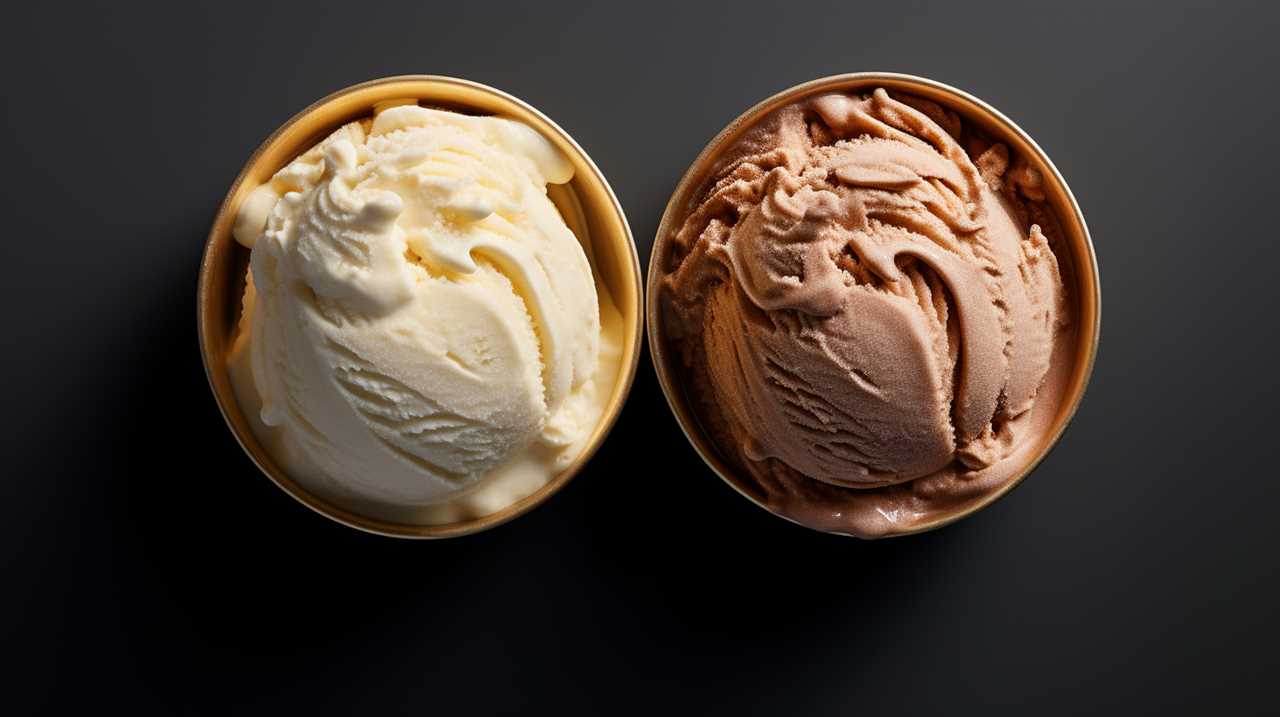
Unique Flavors From Around the World
We’ve discovered some incredible flavors from around the world that have taken our taste buds on a global adventure.
From Japan, we’ve the unique combination of wasabi and soy sauce, which adds a spicy and savory twist to the creamy sweetness of ice cream.
In Italy, gelato enthusiasts enjoy the refreshing taste of olive oil and basil, creating a delightful balance between richness and herbaceousness.
Moving on to Thailand, we find the popular trend of coconut ice cream infused with tangy lemongrass and a hint of spicy chili.

And in Mexico, traditional flavors like avocado and corn are transformed into creamy, indulgent treats.
These exotic combinations showcase the creativity and diversity of ice cream flavors found worldwide, offering us a chance to explore new tastes and expand our culinary horizons.
The Art of Making Ice Cream
To create ice cream, we blend together various ingredients to achieve a smooth and creamy texture. The art of making ice cream has a rich history that dates back centuries. From ancient Chinese techniques of using snow and milk to freeze sweet treats, to the invention of the hand-cranked ice cream machine in the 18th century, the process has evolved over time.
Today, making homemade ice cream is a beloved tradition in many households. Here are four essential steps in creating your own delectable frozen dessert:

- Choose your base: Start with ingredients like cream, milk, and sugar to form the foundation of your ice cream.
- Add flavorings: Whether it’s vanilla extract, fruit puree, or chocolate chips, these additions bring unique tastes to your creation.
- Churn it up: Use an ice cream maker or hand-cranked machine to freeze and mix the base until it reaches the desired consistency.
- Freeze and enjoy: Transfer the churned ice cream into a container and let it set in the freezer for a few hours before indulging in your homemade delight.
Creating homemade ice cream allows for endless experimentation and the satisfaction of enjoying a frozen treat made with love.
Frequently Asked Questions
How Many Calories Are in a Typical Serving of Ice Cream?
In a typical serving of ice cream, the calorie content varies depending on the flavor. Different flavors can range from around 150 to 300 calories per serving. So, indulge mindfully!
What Are Some Common Allergies or Dietary Restrictions Associated With Ice Cream?
Common ice cream allergens include milk, eggs, nuts, and soy. For those who are lactose intolerant, there are alternatives such as dairy-free ice cream made from almond or coconut milk.
Is It Safe to Consume Ice Cream During Pregnancy?
Should we avoid ice cream during pregnancy? Can those irresistible cravings be harmful? Well, let’s dive into this delicious dilemma. From safety concerns to satisfying sweet tooth cravings, we’ll uncover the scoop.
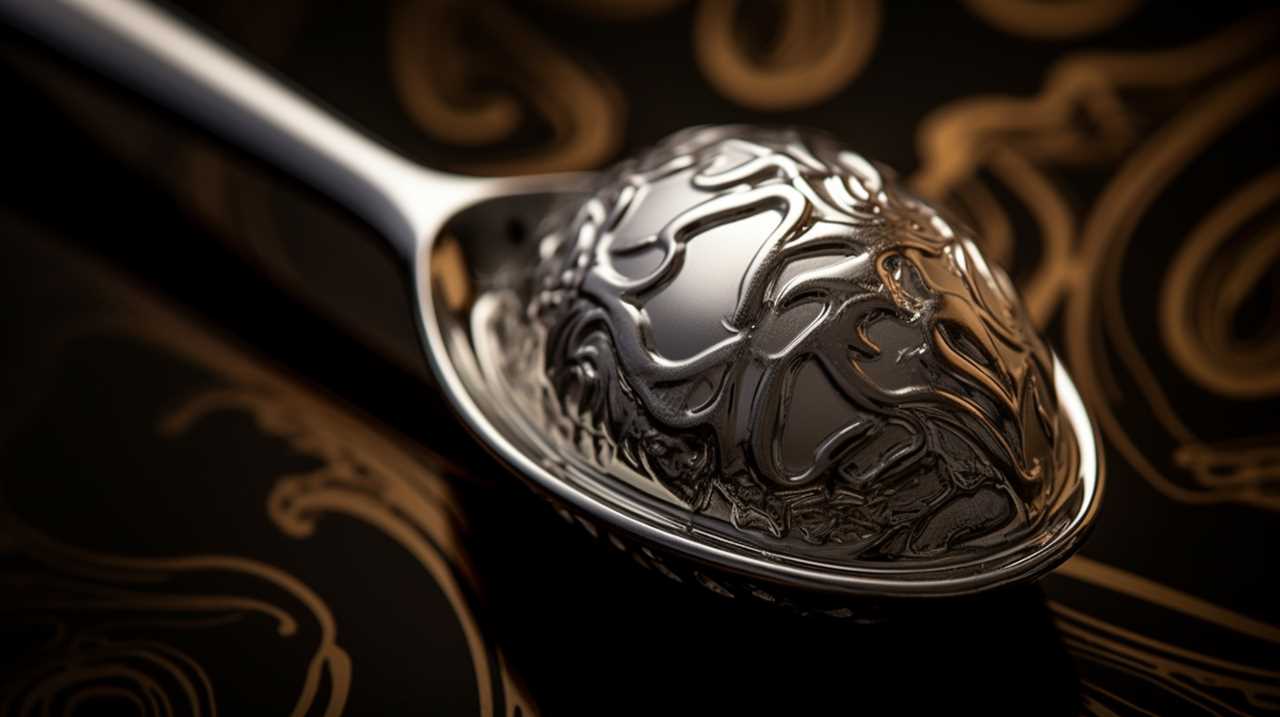
Can Ice Cream Be Made Without Dairy or Lactose?
Yes, ice cream can be made without dairy or lactose. There are plenty of vegan ice cream alternatives available, and homemade ice cream recipes that use non-dairy milk or ingredients like coconut cream or almond milk.
Are There Any Health Benefits to Eating Ice Cream?
Eating ice cream can bring joy to our taste buds, but are there any health benefits? While ice cream is not the healthiest treat, it can provide calcium and protein. Moderation is key!
– What is the difference in the creaminess of ice cream from Jersey cows compared to other sources?
When it comes to jersey cow ice cream secrets, the creaminess factor is unmatched. Jersey cow milk contains higher levels of butterfat and protein, resulting in a richer and creamier ice cream compared to other sources. The superior quality of the milk from Jersey cows makes for a truly indulgent frozen treat.
Conclusion
As we lick the last traces of sweetness from our spoons, let’s remember that ice cream is more than just a treat for our taste buds.
It’s a journey through time, a global delight that has captivated hearts and palates across the world.

From its humble origins to the scientific wonders behind its creamy texture, ice cream is a true work of art.
So next time you indulge in a scoop, savor the flavors and appreciate the craftsmanship that goes into each frozen masterpiece.
Beyond the realm of flavor and technique, Adriano recognizes the importance of sustainability and conscious consumption. His writing often explores eco-friendly practices within the ice cream industry, highlighting the use of locally sourced ingredients, reducing waste, and supporting ethical production methods.
About Ice Cream
Decadent Chocolate Ice Cream Cone Recipe
Indulge in the allure of a decadent chocolate ice cream cone with a recipe that promises a rich and unforgettable treat.

Have you ever wondered that over 90% of people prefer chocolate ice cream over any other flavor?
The allure of a decadent chocolate ice cream cone is undeniable, and our recipe takes it to the next level.
From the first bite of the crispy cone to the rich chocolatey goodness that follows, each element is carefully crafted to create a truly indulgent treat.
But what sets this recipe apart?
Stay tuned to uncover the secrets behind making the perfect chocolate ice cream cone that will have everyone asking for more.
Key Takeaways
- Use rich ingredients like butter and cocoa for decadent flavor and texture.
- Master the art of making crispy cones with the right batter consistency.
- Elevate your cones with gourmet touches like ganache and premium toppings.
- Customize your ice cream cone experience with creative variations and serving ideas.
Ingredients for Decadent Chocolate Ice Cream Cones
For crafting our decadent chocolate ice cream cones, we gather key ingredients like unsalted butter, egg whites, flour, powdered sugar, and black cocoa powder. The unsalted butter provides richness and a smooth texture to the cones, while the egg whites help in binding the ingredients together. Flour acts as the base, giving structure to the cones, and powdered sugar adds sweetness to balance the bitterness of the black cocoa powder. The use of black cocoa powder intensifies the chocolate flavor, making these cones a true delight for chocolate lovers.
When combined and cooked in a waffle cone iron, these ingredients transform into a homemade dessert with a crispy texture that complements the creamy ice cream perfectly. The process of shaping the warm cones into the classic cone shape adds a touch of nostalgia and fun to the treat. The careful balance of these ingredients ensures that each bite is a harmonious blend of flavors and textures, making these chocolate ice cream cones a decadent and satisfying dessert option.
Step-by-Step Instructions
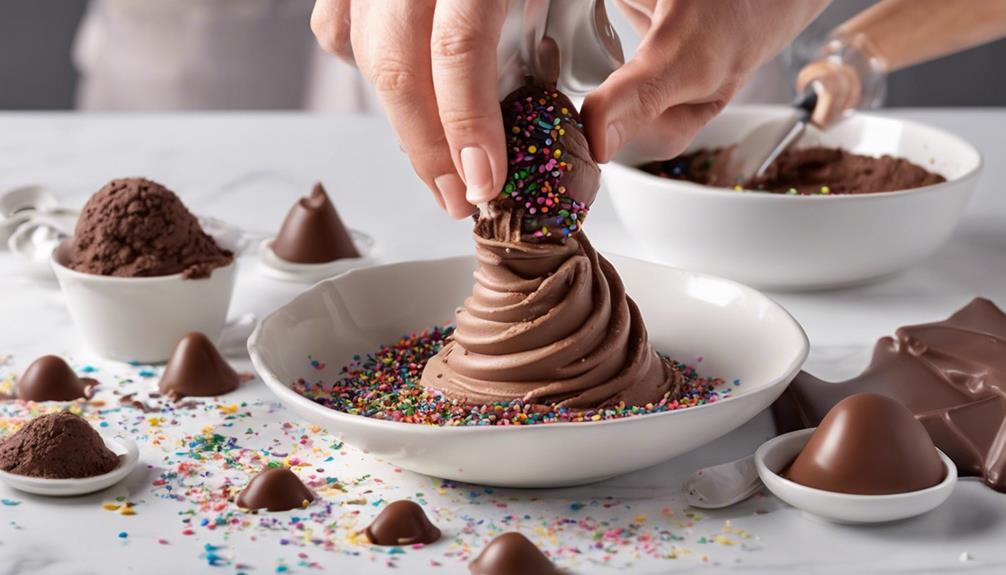
Let's delve into the intricate process of crafting these delectable chocolate ice cream cones step by step.
To begin, melt a combination of chocolate chips and heavy cream in intervals until smooth to create the rich ganache.
Next, carefully create a hole in your chosen ice cream scoops and fill them with the prepared ganache, ensuring each bite is filled with indulgent chocolate goodness.
Then, dip the cones in melted chocolate and quickly coat them with chopped peanuts for a delightful crunch and added texture.
Place the assembled cones on a baking sheet and freeze them until solid, allowing the flavors to meld together perfectly.
For a homemade touch, consider using a waffle iron to create your cones for an added level of freshness and flavor.
These indulgent treats are the perfect balance of creamy ice cream, decadent chocolate, and crunchy peanuts, making them a truly irresistible dessert option.
Enjoy the satisfaction of creating your own chocolate-covered ice cream cones, knowing that each bite is a labor of love and flavor.
Tips for Perfect Chocolate Ice Cream Cones
When crafting perfect chocolate ice cream cones, ensure the batter is spread thinly for crispy results and shape them using a small bowl for waffle bowls. To achieve the ideal texture and flavor, incorporate high-quality dark chocolate or cocoa powder into the batter. This will provide a rich, decadent taste that complements the cold creaminess of the ice cream.
Pay close attention to the batter's consistency; it should be smooth and free of lumps to guarantee a uniform bake. Refrigerating or freezing the batter allows for convenient use over an extended period, ensuring you can enjoy freshly made cones whenever the craving strikes. Adhering to the cone maker's instructions regarding the amount of batter to use per cone is crucial for achieving optimal results.
For an extra touch of indulgence, consider coating the waffle bowls with chocolate to create a waterproof barrier that prevents sogginess. By following these tips, you can master the art of crafting perfect chocolate ice cream cones every time.
Serving Suggestions and Variations

As we explore serving suggestions and variations for our delectable chocolate ice cream cones, enhancing your dessert experience with delightful toppings and creative twists becomes a delightful adventure.
To elevate your homemade ice cream cones, consider setting up a DIY ice cream cone bar at your next gathering. Allow guests to unleash their creativity by offering an array of toppings like sprinkles, chopped nuts, and whipped cream. For a touch of elegance, drizzle melted chocolate over the cones before serving, or experiment with melted white chocolate or caramel sauce for a decadent finish.
To add a twist to the classic chocolate ice cream cone, try incorporating different flavors of homemade ice cream such as mint chocolate chip, cookie dough, or salted caramel. These variations will introduce unique and exciting combinations that will keep your guests coming back for more.
If you're hosting a large event, think about making mini versions of the cones to create bite-sized treats or dessert samplers. These mini cones are perfect for sampling various flavors or for offering a diverse dessert spread.
Frequently Asked Questions (FAQs)
Commonly asked questions about the chocolate ice cream cone recipe often revolve around ingredient substitutions and storage recommendations.
When it comes to ingredient substitutions, some wonder if coconut oil can be swapped for butter. While coconut oil can impart a subtle coconut flavor, it can generally be used as a 1:1 substitute for butter in this recipe. For those allergic to coconut, a neutral oil like vegetable oil can also work well.
Another common question pertains to the batter's consistency. The ideal batter should be thick enough to coat the back of a spoon but still flow easily. If the batter feels too thin, adding a tablespoon of flour at a time until the desired texture is achieved can help.
Storage recommendations often include placing the baked cones in an airtight container once cooled to maintain their crispness. Additionally, to maintain the cones' shape, storing them in an upright position, like in a tall glass, can prevent breakage.
Frequently Asked Questions
Why Do They Put Chocolate in Ice Cream Cones?
We put chocolate in ice cream cones to create a barrier that prevents sogginess and maintains the cold temperature of the ice cream. This addition offers a delightful contrast in texture and taste.
Dark chocolate, with its hint of bitterness, balances out the sweetness of the ice cream. As we enjoy our treat, the chocolate collects at the bottom, providing a tasty surprise.
Ultimately, chocolate in ice cream cones elevates the flavor experience and adds a touch of indulgence to this classic dessert.
What Is the Difference Between a Cake Cone and a Waffle Cone?
When comparing a cake cone to a waffle cone, the key differences lie in their texture and method of preparation.
Cake cones tend to be softer and more delicate, made from a thinner batter that's baked in molds.
On the other hand, waffle cones have a crispy texture, are sturdier for holding ice cream, and are often freshly made in cone irons, featuring a distinct grid pattern.
How Do You Fill an Ice Cream Cone?
We start by preparing our favorite ice cream flavor and letting it soften slightly for easy scooping. Using a spoon or ice cream scoop, we carefully add the softened ice cream into the cone.
To elevate the experience, we can create a hole in the ice cream scoop and fill it with chocolate ganache or other toppings before placing it in the cone.
After filling the cone with ice cream, we dip the top in melted chocolate for an extra layer of indulgence.
Does Baskin Robbins Do Chocolate Dipped Cones?
Oh, absolutely! Baskin Robbins takes their ice cream cones to the next level with those divine chocolate-dipped creations.
The choice between luscious milk chocolate or indulgent dark chocolate to coat those waffle cones is a tough one.
The contrasting textures and flavors of the chocolate with the creamy ice cream make it a popular choice among customers seeking a truly decadent ice cream experience.
Conclusion
In conclusion, these homemade chocolate ice cream cones are a sweet symphony of flavors, like a smooth melody dancing on your taste buds. With a rich chocolate taste and a crispy texture, they're a decadent treat that will satisfy your dessert cravings.
Indulge in the luxurious depth of flavor from the black cocoa powder and butter, and create a delightful experience with every bite. Treat yourself to these delightful cones and elevate your ice cream experience to a whole new level.
Mario’s creativity shines through his ability to describe the sensory experience of enjoying ice cream. Whether he’s discussing the velvety texture, the explosion of flavors, or the delightful combinations of toppings and sauces, his words transport readers to a world of mouthwatering sensations. His descriptive language allows readers to imagine and savor the flavors even before taking the first bite.
-

 Beginners Guides4 weeks ago
Beginners Guides4 weeks agoHow to Do When Your Ice Cream Tastes Gritty: Quick Fixes
-

 About Ice Cream2 weeks ago
About Ice Cream2 weeks agoWhat Military Diet Rules Allow Ice Cream?
-

 Beginners Guides4 weeks ago
Beginners Guides4 weeks agoCreamy Remedies: Good Ice Cream Choices for Acid Reflux Relief
-
Beginners Guides3 weeks ago
10 Differences Between Ice Cream and Popsicles
-

 Creative Ice Cream Recipes2 months ago
Creative Ice Cream Recipes2 months agoWho Makes Dairy Queen Ice Cream
-

 About Ice Cream2 weeks ago
About Ice Cream2 weeks ago10 Reasons Why You Feel Like Throwing Up When You Eat Ice Cream
-

 About Ice Cream2 weeks ago
About Ice Cream2 weeks agoHow Pouring Milk on Ice Cream Causes Ice Crystals
-

 About Ice Cream2 weeks ago
About Ice Cream2 weeks agoWhat Makes Ice Cream Essence Essential in Creamy Treats?





